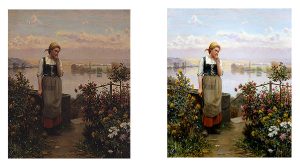COMMENTS ON THE ART MARKET
Gallery Exhibition
Small Works Show
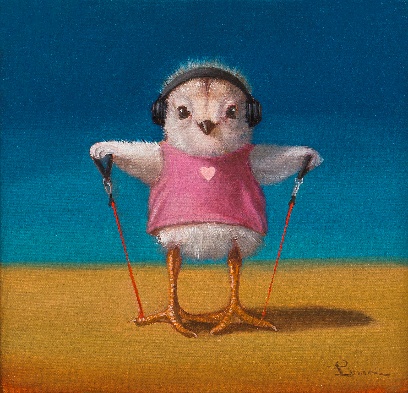
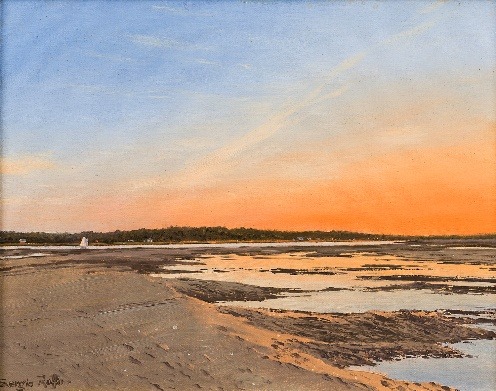
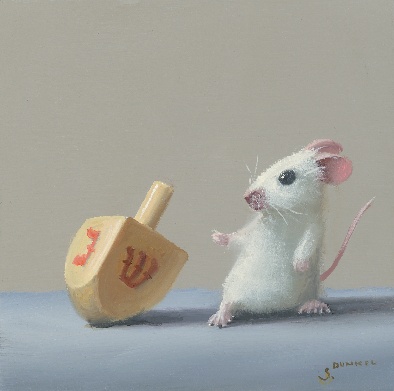
Show Dates:
November 30th, 2024 – January 10th, 2025
Our Small Works Show, featuring over 90 works, is now open online. Included are paintings by many of our contemporary artists, including Todd Casey, Stuart Dunkel, Tony South, Sergio Roffo, Lucia Heffernan, Gail Descoeurs, Andrew Orr, Beth Sistrunk, Ryan Brown, Carrie Goller, Mark Daly, Jon Burns, Ken Salaz, Ben Bauer, and many others.
Imagine a family member or friend unwrapping a beautiful work of art from Rehs Contemporary Galleries’ Small Works Show—the perfect surprise to dazzle your loved one this holiday season. These miniature masterpieces may be small in size but pack a mighty punch of artistry and charm, making them ideal for Christmas stockings or a cozy spot near the Menorah. Whether it’s a luminous landscape or a furry little friend, each piece is a testament to incredible craftsmanship and a unique gift. Who needs another sweater when you can give the gift of timeless beauty that will last a lifetime?
Many of the paintings in the show will be on display at the gallery beginning Monday, December 1st.
____________________
Stocks & Crypto
First and foremost, I hope you and your families all had a nice Thanksgiving!
This time of the year, we are always reminded to be thankful… and investors had plenty to give thanks for this month, with the stock market delivering one of its strongest performances of the year.
It's hard not to start this by acknowledging the effect that Trump's win has had on the stock and crypto markets… it was a seismic shock. The only reasonable explanation is that the markets were pricing in a different outcome, and these jumps were correcting for future expectations. I guess we'll see how that all shakes out over the next few years, but this month, we saw some major moves.
All three indexes turned in sizable gains, with all-time highs along the way… the S&P notched about a 5% gain in November, and that was the least of the trio. The Dow added 7.5%, while the Nasdaq logged a 6+% gain. A significant influence for the S&P was Tesla's jaw-dropping 36% month, along with a surge in the financial sector. Notably, Discover was up more than 23% on speculation that Trump will greenlight their merger with Capital One. The Dow saw significant contributions from Disney (+22%), Goldman Sachs (+16.7%), and Salesforce (+13%).
The European currencies moved in sync; both the Pound and Euro weakened relative to the dollar by about 2% through November. Crude futures fluctuated in a relatively tight range and finished things off about 1% higher. Gold has pulled back from the record levels we saw last month but is still hovering at a lofty level in the mid $2,600s… that said, November did shed a bit more than 2%.
Crypto investors had Bitcoin teasing the elusive $100k milestone… it topped out at $99,849.99 last Friday (the 22nd) and has been testing the limit ever since – it is currently sitting at about $97.5K, which is good for a 35% month. Ethereum and Litecoin saw similar movements… in fact, both fared a bit better, with 37% and 39%, respectively. This is probably a good time to bring up the fact that I'm still holding my Dogecoin, which skyrocketed this month with a 150% gain – I'm now up more than 4,000% on that bad boy!
With the S&P posting its biggest monthly gain in a while and the Dow having its best 2024 showing, there's optimism heading into December. Still, the broader economic uncertainties—geopolitical risks, tariff threats, inflationary pressures, and consumer spending habits—ensure that the road ahead will be anything but smooth.
____________________
Really!?
An Extraordinary Roosevelt Dime
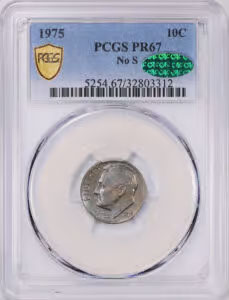
1975 Dime
In Toledo, Ohio, an extraordinary dime sat tucked away in a vault for over forty years! What makes this dime minted in 1975 so special? It is missing its mint mark. All coins in the United States have a small letter just below Franklin Roosevelt’s head, indicating where it was created: Denver (D), Philadelphia (P), San Francisco (S), and West Point (W). This dime was minted in San Francisco, yet is missing its mint mark, making it one of the two markless coins from the nearly three million dimes minted in 1975. Talk about special!
Three sisters from Ohio inherited this rare dime from their brother, who had cherished it as a family heirloom. Their parents had bought it back in 1978 for $18,200 (equivalent to about $90,000 today), hoping it might serve as a financial safety net. Little did they know just how valuable it would become! After many years and careful consideration, the sisters decided it was the right time to auction it off.
The excitement was palpable as over 200 bids poured in, and a collector snagged the coin for an impressive $450,000 ($506,250 w/p). Interestingly, the other “No-S” dime sold in 2019 for $380,000 ($456,000 w/p) and was resold just months later for $516,000 to a private collector. Both 1975 “No-S” dimes are legendary in the coin-collecting world, and enthusiasts are always on the lookout for hidden treasures like these that could pop up in their spare change.
Ultimately, the story of the Ohio sisters and their incredible dime shows us how small details can turn an ordinary 10-cent piece into something truly remarkable — especially when it’s been cherished and protected over the years!
Dazzling Diamond Necklace Dances Across The Auction Block
A dazzling 300-carat diamond necklace played a key role in an eighteenth-century scandal and is rumored to have played a significant role in the fall of the French monarchy. Recently, it took center stage at a Geneva auction. With nearly 500 glittering diamonds arranged in three luxurious rows cascading into an elegant tassel, this masterpiece of Georgian-era craftsmanship was more than just jewelry — it was a captivating slice of history, full of intrigue and drama.
As the story goes, the infamous diamond necklace’s creation traces back to 1772, when King Louis XV of France commissioned it as an opulent gift for his mistress, the Madame du Barry.
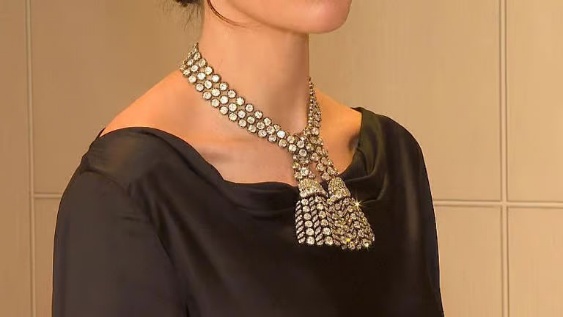
Diamond necklace
Crafted by jewelers Charles Auguste Boehmer and Paul Bassenge, the necklace was intended to be the most spectacular piece of its time, valued at an astounding 2,000,000 livres (roughly $17.5 million in 2024). Tragically, before the necklace’s completion, the king succumbed to smallpox, leaving the jewelers with an unsold masterpiece and no royal buyer. Hoping to salvage their investment, the jewelers later offered the necklace to the new queen, Marie Antoinette. However, she declined the extravagant piece, partly due to its association with Madame du Barry (with whom she did not have the best relationship) and partly because she found such a lavish expense unnecessary.
This rejection left the jewelers scrambling to find a buyer, and the necklace eventually became entangled in a web of deceit. The ensuing events triggered the notorious Affair of the Diamond Necklace. This scandal unfairly implicated Marie Antoinette, damaging her reputation and fueling unrest in the waning years of the French monarchy.
The woman behind the scandal was a con artist, Jeanne de la Motte, who deceived Cardinal de Rohan into believing the Queen wanted to secretly purchase an extravagant diamond necklace. Using forged letters and a staged meeting with a Marie Antoinette impersonator, Jeanne acquired the necklace and absconded. When the scheme unraveled, a public trial ensued in 1786, resulting in De la Motte’s conviction.
Fast forward to the twentieth century, when the necklace graced the neck of the Marchioness of Anglesey at Queen Elizabeth II’s coronation in 1953. Eventually, it found its way into private hands, disappearing from public view until now.
The allure of such a historic piece was electric, and the auction room buzzed with excitement as bids poured in. It was estimated to make 1.6 to 2.2M Swiss francs (or $1.8 to 2.5M). When the hammer fell, this jaw-dropping treasure sold for a cool 3.55M francs (or $4M; 4.26M francs / $4.8M w/p). It may have beaten its estimate, but the final price is a far cry from its original value.
Titanic Pocket Watch Sails To A New Auction Record
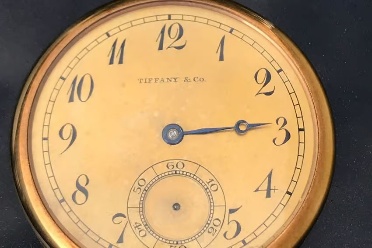
Arthur Rostron’s
Tiffany & Co. gold pocket watch,
which he received from
Titanic survivors
The gold pocket watch belonging to one of the main characters of the Titanic tragedy recently sold at auction for a record price.
Captain Arthur Henry Rostron, a distinguished British naval officer, was born on May 14, 1869, in the Astley Bridge neighborhood of Bolton, England. At just 13 years old, he embarked on a career in the Merchant Navy, where his diligence, leadership, and dedication to duty quickly earned him recognition. By 1912, he had ascended to the rank of captain of the RMS Carpathia, a passenger ship operated by the Cunard Line.
Rostron’s name became synonymous with heroism during the Titanic disaster on the night of April 14-15, 1912. When the Carpathia received the Titanic’s distress call after it struck an iceberg, Rostron immediately ordered the ship to maximum speed. Navigating perilous ice fields in complete darkness, he and his crew managed to rescue 705 survivors from lifeboats in freezing conditions. For his decisive leadership and courage, Rostron received widespread acclaim. President William Howard Taft awarded him the U.S. Congressional Gold Medal, and he was later knighted by King George V.
Recently, Rostron’s legacy returned to the spotlight with the auction of a remarkable artifact connected to his heroism. His gold Tiffany & Co. watch, crafted in 18-carat gold and inscribed with a message of gratitude, recently sold at auction. The inscription reads: “Presented to Captain Rostron with the heartfelt gratitude and appreciation of three survivors of the Titanic. April 15, 1912. Mrs. John B. Thayer, Mrs. John Jacob Astor, and Mrs. George D. Widener.” The three women were the widows of prominent American businessmen who all perished in the sinking.
Initially valued at £80K to £120K, the watch surpassed all expectations, fetching an extraordinary £1.28 M / $1.6M (or £1.56M / $1.97M w/p) — a record-breaking price for Titanic memorabilia. Now owned by a private collector, the watch is a testament to Rostron’s bravery and the lives he saved during one of history’s most infamous maritime disasters. The previous record for a Titanic-related object was a pocket watch once owned by John Jacob Astor, which sold for £1.175 M ($1.485 M) earlier this year.
____________________
Tales From The Dark Side
Royal Warhol Heist
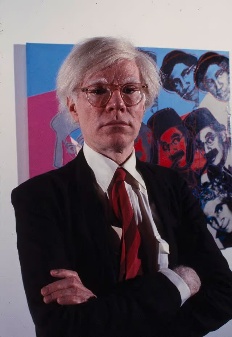
Andy Warhol
Last Friday, some royal portraits by Andy Warhol were stolen from a gallery in the Netherlands in an ‘explosive’ heist.
In 1985, Andy Warhol created a series of large prints known as the Reigning Queens series. The series consists of portraits of four different queens from around the world reigning at the time: Queen Elizabeth II of the United Kingdom, Queen Beatrix of the Netherlands, Queen Margrethe II of Denmark, and Queen Ntfombi of Eswatini (formerly Swaziland). Warhol experimented with various color combinations throughout the series and even created what became known as a Royal Edition, using ground-up glass to provide a sparkle. MPV Gallery in Oisterwijk, a small town about 40 miles southeast of Rotterdam, had several of the Warhols on display since they were due to be exhibited at the PAN art fair in Amsterdam starting November 24th. However, at around 3:05 am on the morning of Friday, November 1st, a group of burglars broke into the gallery using explosives to destroy the front doors. The gallery owner, Mark Peet Visser, later said that nearly the entire front of the building was destroyed, with the door handle found 160 feet away. The robbers made off with four Warhol prints, one of each queen. However, they found themselves in trouble when they could not fit them into their car. So they decided to rip two of them from their frames (one of Queen Elizabeth and the other of Queen Margrethe) and leave the other two damaged in the street. Visser called the act “appalling” and “unprofessional”.
Police have carried out several raids in the surrounding area, first finding the getaway car and then arresting one of the suspects. The unnamed 23-year-old man was apprehended in the nearby town of Berkel-Enschot. There has been no mention that the stolen Warhols have been recovered. Arthur Brand, a prominent art detective who relocated a stolen Van Gogh painting last year, has commented that the perpetrators were likely not well-versed in stealing art from a museum or gallery setting. “I think it was some criminals who are not really specialized in art theft, saw an opportunity and thought: Let’s first steal them and afterwards see what we can do, and everything went wrong.” Even though stolen modern and contemporary art is relatively easier to sell than Old Master paintings, the prints are all catalogued and numbered as part of the series. With this readily-available information, plus the news attention the robbery has received, it will become incredibly difficult for the robbers to sell or otherwise dispose of the Warhols.
NFT Scammers Convicted

An example of blockchain code
for an NFT
The creators of an NFT series have recently been convicted of operating a ‘rug pull’ scam to steal investors’ money.
Berman Jerry Nowlin Jr., known by the screen names Repulse and Zayous, is a 21-year-old man from the Tampa area who, along with US Air Force officer Devin Alan Rhoden, has been found guilty of conspiracy to commit wire fraud and money laundering in relation to their NFT series. The pair previously found success with two NFT series known as the UndeadApes and the Undead Lady Apes, both of which are zombie versions of the once popular, now controversial NFT series Bored Apes Yacht Club. The UndeadApes series was very successful with investors and collectors. Each work initially sold for $5, but some examples were resold for as much as $360.
The fraud scheme in question started around April 2022 when the duo created a new series called Undead Tombstone. According to court documents, the two developed what is known as a ‘rug pull’ scheme. They minted 632 NFTs while lying about their value to lure buyers and investors to the project. Specifically, they misleadingly stated that the new series was a collaboration between the UndeadApes brand and the popular NFT collection Stoned Apes. Stoned Apes denied there being such a collaboration. When buyers began reaching out about the false statements, Nowlin and Rhoden deleted all their social media accounts and blocked off any way for their victims to communicate with them. Their confused customers were only left with the NFT, which was now devoid of all value. Nowlin and Rhoden used a Solana blockchain, both to create the NFTs and collect the cryptocurrency payments. After severing contact, they transferred the cryptocurrency funds off the Solana blockchain onto a different, Ethereum-powered blockchain to hide their ill-gotten gains. This is known as ‘chain-hopping’, and has become a common way to launder money via cryptocurrency. Nowlin and Rhoden swindled $135K using the Undead Tombstone rug pull scheme. In total, they made nearly $400K from all of their NFT ventures.
A Florida jury found both men guilty of the charges against them on October 31st. They each face a maximum of five years in prison, with Rhoden’s sentencing scheduled for November 20th and Nowlin’s on January 23rd. This is only the latest installment in the saga of bad press and legal troubles for those involved in cryptocurrency and blockchain technologies, most notably the collapse of the FTX exchange and the conviction of its CEO, Sam Bankman-Fried.
Forgery Conspiracy Unveiled In Italy

Carabinieri officers posing
with confiscated forgeries
In June, I wrote about how Italian authorities confiscated a drawing being passed off as an original by Amadeo Modigliani. It is based on a real Modigliani drawing from his Caryatid series, sketches he made between 1912 and 1914 as preliminary drawings for a sculpture series. Recently, another fake drawing based on Modigliani’s Caryatids led Italian authorities to uncover a massive forgery conspiracy active in several European countries.
In what has been called Operazione Cariatide, the Carabinieri, prosecutors in Pisa, and Eurojust have opened investigations into 38 people residing in Italy, Belgium, France, and Spain. In what the Italian press is calling a “maxi-sequestro”, or a mega-seizure, the Carabinieri have since raided six locations uncovered as workshops and confiscated over 2,100 fakes and forgeries. Had they been authentic, this haul would have been worth around €200 million. The forgeries were predominantly based on works by modern and contemporary artists like Picasso, Kandinsky, Basquiat, Pollock, Chagall, Miró, and many others. Warhol and Banksy forgeries are considered this conspiracy’s specialty.
The investigation into this forgery ring started in March 2023 when a businessman in Pisa had his art collection confiscated, which included about 200 forgeries. Among these was another fake Modigliani Caryatid, which eventually gave the investigation its name. This led to them monitoring both auction houses and e-commerce platforms. They soon traced many fake works offered at regional Italian auction houses back to a group of forgers operating workshops in Venice, Lucca, and Pistoia. After looking into these individuals, they uncovered an entire network extending beyond just Italy. The Italian authorities are not only going after the forgers but also auction house employees who may have knowingly worked with the forgers to sell these works. There may also be others who are complicit, as investigators have found that the forgers staged exhibitions for some of their Banksy fakes to give them a sense of provenance and legitimize them. Over 18 months, another three forgery workshops were uncovered where there were not only fake artworks but also counterfeit certificates and stamps to fool specialists and investigators.
The Carabinieri is exhibiting the confiscated forgeries at Pisa’s Palazzo Toscanelli between November 11th and 15th.
Bouvier Sent To Trial Over Missing Picassos

Yves Bouvier
(photo courtesy of
Hpetit21/Creative
Commons)
On top of his tax troubles, Swiss art dealer Yves Bouvier seems to be in even more legal trouble. This time, it concerns some missing Picassos.
On November 7th, an appeals court in Paris quashed Bouvier’s attempts to dismiss the case against him concerning about 70 works by Pablo Picasso that disappeared from a storage unit nearly a decade ago. The story began in 2008, when Bouvier’s business partner, Olivier Thomas, placed these works in the unit run by Bouvier’s company, Art Transit International, in the suburbs of Paris. He did so on behalf of Catherine Hutin, Picasso’s stepdaughter. At some point, Hutin discovered that these paintings and drawings had gone missing. Her sights were set on Bouvier no later than 2013 since she alleges that two of the items on her missing list, a pair of 1957 portraits of her mother Jacqueline Roque Picasso, were sold by Bouvier to Dmitri Rybolovlev for $28.5 million. Bouvier claims he bought those paintings from gallerist Jean-Marc Aittouares, yet he has not produced any documents relating to his purchase. He also claimed at one point that, yes, the portraits once belonged to Hutin but that she had sold them to him for €9 million in 2010. Hutin did indeed sell some paintings for €9 million that year, but it was for a different group of paintings rather than the portraits in question.
Adding further intrigue to the affair, a conservator contacted Hutin, saying that Olivier Thomas hired him to perform some light conservation on five paintings in storage. When she checked, these paintings were missing as well. This same conservator also stated he worked on three Picassos at Bouvier’s offices at the Geneva Freeport. The three paintings were also on Hutin’s list of work missing from her storage unit. Hutin first filed suit against Bouvier and Thomas in 2015.
Yves Bouvier and Olivier Thomas are charged with possessing stolen property, while Thomas is also facing an additional fraud charge. They have tried to stall the proceedings by claiming that the investigation was influenced by the legal team of his former adversary, Dmitri Rybolovlev. However, the court stated that it found “no evidence of partiality” from the investigators. With the court’s most recent ruling, these claims have been dismissed and their case will go to trial. Bouvier and his lawyer have said they intend to appeal the case to the Court of Cassation, the highest court in French civil and criminal cases. So, while Bouvier is free from Rybolovlev’s lawsuits, he’ll still be in court for the foreseeable future.
____________________
The Art Market
Sotheby’s New York Sydell Miller Collection
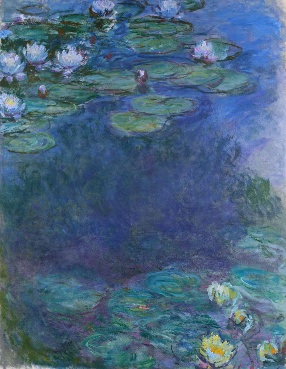
Nymphéas
by Claude Monet
The November sales at the New York auction houses kicked off on Monday at Sotheby’s with the evening sale featuring the collection of Sydell Miller. Having made a name for herself in the hair care business, Miller passed away at age 86 this past March. On Monday, November 18th, the highlights of her art collection were the first to cross the block.
Of course, the collection’s star was the Claude Monet water lily painting. The bidding started at $40 million and quickly reached $50 million within the first two minutes. Things slowed down once it got to $55 million, with fourteen minutes elapsing between the $50 million bid and the winning bid. Auctioneer Oliver Barker referred to it as “one of the most important works from Monet’s water lily series to be offered at auction this century”. He later referred to it as “this ravishing thing”, and at the $58.5 million mark described the moment as “once in a generation”. I couldn’t help but laugh when he said that because it seems like a Monet water lily painting such as this, from his later life with a stamped signature, comes to auction about once or twice every year rather than once in every generation. But still, the hammer came down at $59 million (or $65.5 million w/p), slightly under the $60 million pre-sale estimate. The painting is now in the top ten most valuable works by Monet ever sold at auction, just squeezing by the painting of Waterloo Bridge sold for $64.5 million w/p at Christie’s New York in November 2022 as part of the Paul Allen collection.
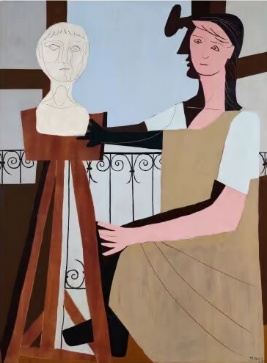
La Statuaire
by Pablo Picasso
A little later on came the sole Picasso painting of the collection. La Statuaire dates to 1925, having last sold at auction at Sotheby’s in 1999 for $11.8 million w/p. Picasso gives us a blend of cubism with a touch of neoclassicism, showing a woman seated beside a bust before a set of open French doors. According to Sotheby’s specialists, the painting represented further progression in Picasso’s development as an artist, or “the multifaceted modes of Picasso’s artistic expression.” Galerie Paul Rosenberg was the first to own the painting before moving around several different private and public collections, including New York’s Museum of Modern Art. It was one of the paintings selected for Picasso’s first American exhibition at the Wadsworth Atheneum in 1934. Bidding started at $15 million and climbed steadily to $20 million within 30 seconds. After about three minutes of bidding, the Picasso was sold for $22 million (or $24.8 million w/p), quite a bit less than the $30 million Sotheby’s expected.
In between the Monet and the Picasso came another one of the predicted top lots. Wassily Kandinsky’s 1921 painting Weisses Oval has an illustrious provenance. Between 1945 and 1971, it was part of the collection at the Guggenheim Museum in New York. After going to auction at Sotheby’s, it passed through a few collections before ending up at Thomas Ammann Fine Art in Zürich, having bought it jointly with Galerie Beyeler and Carlo Bilotti. Miller acquired the painting from Landau Fine Art in Montreal in 2000. Weisses Oval is also important from an art-historical perspective since it is one of the last paintings Kandinsky created before he moved from Russia to Berlin, marking his further departure from trends in the Russian avant-garde art movement and solidifying his own conceptions of form and color. Bidding began at $12.5 million, climbing steadily before the hammer came down at $19.1 million (or $21.6 million w/p), on the higher side of its $15 million to $20 million pre-sale estimate range.
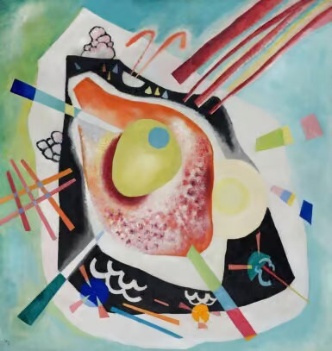
Weisses Oval
by Wassily Kandinsky
With these incredibly expensive collections full of blue-chip artists, there are not often many surprises. However, the first lot of the night seemed to have been an indicator of the collection’s later success; an Edgar Degas bronze ballerina sculpture, entitled Grande arabesque, troisième temps. Degas designed the bronze no later than 1895, with this particular piece cast in 1919, a couple of years after the artist’s death. It last sold at Sotheby’s London in December 1986 for £220K w/p (or about $315.5K w/p at the time). Sotheby’s specialists gave it an estimate range of $400K to $600K. When Oliver Barker brought down the hammer at $1.4 million (or $1.68 million w/p), the room erupted with applause, knowing it would be an interesting evening. Thirteen of the twenty-five lots were statues and sculptures by various artists, including Claude Lalanne, Joan Miró, and Henry Moore.
Overall, the evening sale was successful. Eight of the twenty-five available lots sold within their estimates, giving Sotheby’s a 32% accuracy rate. The same number of lots (32%) sold above their estimates, while nine (36%) sold below. In total, Sotheby’s brought in $189.54 million (or $215.95 million w/p) against a total minimum pre-sale estimate of $169.5 million.
Sotheby’s New York “The Now” & Contemporary
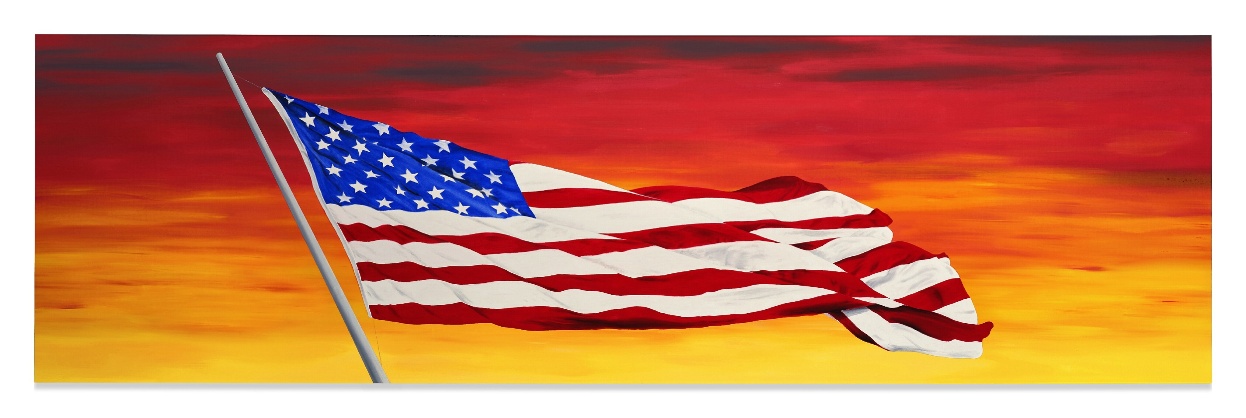
Georges’ Flag by Ed Ruscha
On Wednesday, November 20th, Sotheby’s hosted their contemporary evening sale, including what, for the past several years, they have referred to as “The Now.” While it did not breach into the top lots, most of the talk surrounding this sale concerned Maurizio Cattelan’s world-famous piece of concept art known as The Comedian, consisting of a banana adhered to a wall with silver duct tape. I originally thought the lot would include concept drawings or one of the official installation guidelines the artist provides for any gallery or museum that licenses the work. However, I was somewhat surprised to see in the lot notes that a banana and duct tape were the work’s sole media. The famous fruity work of conceptual art ran straight past its pre-sale $1.5 million high estimate, achieving a final hammer price of $5.2 million (or $6.24 million w/p). The buyer was soon identified as cryptocurrency entrepreneur Justin Sun, who called The Comedian “a cultural phenomenon that bridges the worlds of art, memes, and the cryptocurrency community.” Not the ideas I associate with the work, but whatever floats your boat. Sun later announced his intention to eat the banana, transforming a commentary on the nature of art in the style of Marcel Duchamp into history’s most expensive grocery delivery.
The Cattelan may have been the star of the evening, but it was not the most valuable lot. That distinction goes to the 1999 Ed Ruscha painting Georges’ Flag. The work shows a billowing American flag against a fiery sky, based on a photograph Ruscha took of a large American flag at the Santa Monica Pier, the western terminus of Route 66. Georges’ Flag is a continuation of Ruscha’s longtime fixation on signs and symbols. Sotheby’s specialist Lisa Dennison describes it as “a bridge between realism and the graphic power of pop art.” Ruscha would return to the American flag as a subject later on in his career, treating it as a symbol in the same way that his pop art contemporaries like Jasper Johns would famously do. The enormous painting, measuring over 10 feet long, last sold at auction in 2005 at Christie’s for $1.6 million w/p. It fared far better this time around, selling slightly above its $12 million pre-sale high estimate at $13 million (or $13.65 million w/p).
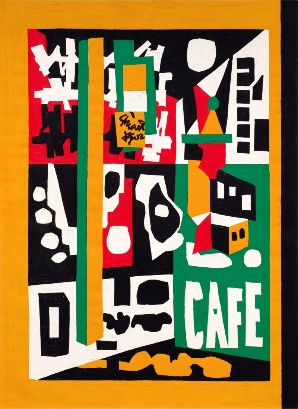
Contranuities
by Stuart Davis
In second place came a rather refreshing addition to the sale. The work of Stuart Davis, I think, is seldom highlighted at the big-budget evening sales at the major auction houses. He is known for his modernist take on daily life, and many refer to Davis as a precursor to pop art. His 1963 painting Contranuities displays a wide range of influences, drawing on both color and form from cubist art, Matisse, Mondrian, and Leger. Contranuities had previously been in the same private collection for over forty-five years, with the seller acquiring it from Andrew Crispo Galleries in 1978. The painting was also predicted to set a new auction record for the artist. His 1928 painting Rue Lipp previously held that title, selling for $6.8 million w/p at Sotheby’s New York in 2018. Even though it did not quite reach the $12 million minimum estimate. Contranuities regardless shattered this record, selling for $10.5 million (or $12.2 million w/p).
And finally, the third successful high-value lot at the evening sale was Untitled XXV by the legendary Dutch-American abstract expressionist Willem de Kooning. The 70-by-80-inch painting, with its flowing designs on a white field, is reminiscent of Kandinsky’s work from the 1920s. Sotheby’s lot notes describe Untitled XXV as “calligraphic”, since it is more calm than his early works and more representative of him settling into life in East Hampton, New York, by the 1980s. Comparing this painting with his earlier works, particularly his Woman series from the 1950s, shows the development of his artistic style over the decades. Untitled XXV ended up just squeezing by the specialists’ $9 million low pre-sale estimate, achieving $9.4 million (or $10.9 million w/p).
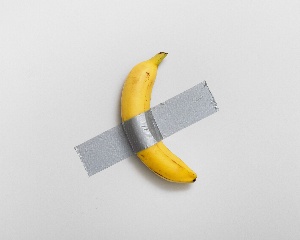
The Comedian
by Cattelan
Along with the Cattelan, Sotheby’s saw several other surprises that evening. Roy Lichtenstein’s 1992 Oval Office (Study), for example, attracted a great deal of attention, exceeding its $1.5 million high estimate by a factor of 2.3, hammering at $3.5 million (or $4.2 million w/p). Furthermore, the last lot in the sale, the 2022 silkscreen Black Dada (K) by Adam Pendleton, hammered at $850K, or 3.4 times its $250K high estimate. However, Sotheby’s faced a slight problem when some of the evening’s lots failed to gain traction with bidders and wound up unsold. These included the sculpture Woman in Tub by Jeff Koons (est. $10 million to $15 million) and the multimedia Jasper Johns work Evian (est. $6 million to $8 million). So even though only five of the forty available lots failed to sell, they resulted in Sotheby’s failing to hit their total pre-sale estimate low of $103.2 million. With fifteen lots selling within their estimates (38%), thirteen selling above (33%), and seven selling below (18%), Sotheby’s brought in slightly less at $98.4 million (or $112.3 million w/p).
____________________
New Artist
Rasa Kluonius
We are pleased to introduce our newest addition to the gallery – the work of Rasa Kluonius. The Lithuanian-born artist uses heavy brushwork and thickly applied layers of paint to create artwork that blurs the lines between abstract and realism. Much of her subject matter is inspired by nature, often painting still lifes and landscapes in bold color. As Rasa says herself, “I like to capture the mundane and the extraordinary; from simple groupings of flowers in a vase, to vibrant landscapes.”

Hydrangea Bouquet
____________________
Deeper Thoughts
Donatello Restoration Underway
In October, I discussed how restoration efforts on the Apollo Belvedere have recently finished. The ancient marble sculpture will be displayed at the Vatican Museums. Now, another prominent Italian sculpture will get its own makeover: Donatello’s statue of Gattamelata.
Gattamelata was the nickname for Erasmo di Narni, who became well known in northern Italy as a condottiero, or a mercenary commander. In the early to mid-fifteenth century, he led armies on behalf of Florence, Venice, and the Papacy. The name ‘Gattamelata’ literally means ‘honeyed cat’, a moniker supposedly given to him because of his charisma and persuasion skills. The Florentine sculptor Donatello spent three years creating a bronze equestrian statue in honor of the soldier, with some sources indicating that the Republic of Venice paid for it as a gift.
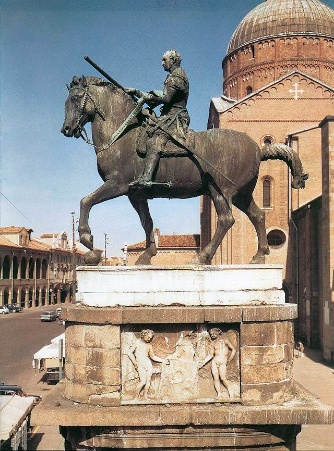
Equestrian Statue
of Gattamelata by Donatello
The statue is incredibly significant from an art historical perspective for several reasons. Firstly, it is one of the first major equestrian sculptures created in Europe since antiquity, with one of the only examples before Donatello being the Bamberg Rider, a stone sculpture in Germany made without little anatomical accuracy and was not made in the round. The Gattamelata statue is also the first bronze equestrian statue made since antiquity. In the thousand years between antiquity and the Renaissance, European artists neglected the process of casting bronze on a large scale to the point that the knowledge was somewhat lost. This made Donatello’s work all the more significant, not just aesthetically but technically as well. Furthermore, the statue ended up repopularizing the style of equestrian portraiture among European artists. Donatello drew inspiration from the ancient Roman equestrian statue of the emperor Marcus Aurelius, which he was able to study up close while living in Rome prior to his residency in Padua. However, in the original ancient statue, the emperor is shown as larger than life, while the horse remains life-size. It almost seems like Marcus Aurelius is riding a pony or something. With the statue of Gattamelata, Donatello made both horse and rider anatomically proportional, with the subjects’ positions and other symbolism conveying their importance instead of physical size. This was groundbreaking for the fifteenth century, especially since Gattamelata broke the norm of who received public commemoration and memorialization in Europe at the time. While public statues of religious figures and the nobility or royalty were normal, Gattamelata was born a commoner who rose up through the military to conquer and rule cities in northern Italy on behalf of Venice. It is not only one of the great works of the early Renaissance, but it has become a symbol of Padua’s cultural and civic pride. And now, at over 570 years old, the early Renaissance bronze is in dire need of some restoration.
Recent tests have revealed some severe corrosion of the bronze, highlighting the urgent need for restoration. The stone plinth supporting the statue also requires attention to ensure its stability. The Pontifical Delegation to the Basicila di Sant’Antonio, outside of which the statue is displayed, is one of the main organizations spearheading the restoration efforts. The University of Padua’s Interdepartmental Archaeology, Architecture, and Art-Historical Research, Study, and Conservation Center (CIBA) will also be contributing towards Gattamelata’s conservation, along with several nonprofit cultural organizations like Save Venice and Friends of Florence. Father Antonio Ramina, rector of the Basilica di Sant’Antonio, commented, “With the generosity of the two American foundations, [the restoration] translates into concrete action the belief in the universality of cultural heritage’s value to humanity entire regardless of where it is.” To fully study the statue, it will need to be temporarily relocated to a place where specialists can easily access it and also protects it from the elements. Friends of Florence have enlisted the help of restorer Nicola Salvioli, who worked with the organization to restore Lorenzo Ghiberti’s baptistry doors, known as the Gates of Paradise. Of the entire Gattamelata statue, the horse itself seems to be the top priority for the restoration efforts, as its slender legs have grown steadily weaker over the centuries and may not be able to support the entire 3,400-pound statue. Padua’s cultural councilor, Andrea Colasio, said it constitutes “the first element of a larger, systemic puzzle”. Some speculate that the work on Gattamelata will likely serve as a place where new conservation practices and methodologies could be tested, setting new standards for the future of bronze sculpture restoration.
MoMA Going Back To Its Roots
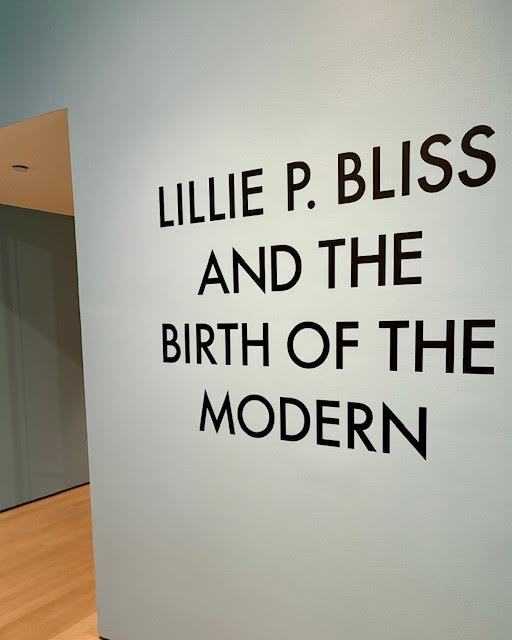
Bliss collection
This past Sunday, November 17th, the Museum of Modern Art in New York opened a new exhibition called Lillie P. Bliss and the Birth of the Modern. The show focuses on a fascinating story: the contributions of one of the museum’s founders. Specifically, it looks into how she influenced the MoMA and modern art connoisseurship in the United States.
Lillie Plummer Bliss was a Massachusetts-born New York socialite, the daughter of a successful dry goods and textile merchant. At age 45, she attended an exhibition of the work of Arthur Davies, marking the beginning of her personal journey into the world of modern art. After buying one of his paintings, Davies recommended she learn more about the modernists active in Europe at the time, including Cézanne and Degas. From then on, she started collecting modern European art and displaying it in her home. In time, she became one of the premier collectors of Cézanne paintings in the United States. She went on to become a major source of funding for the 1913 Armory Show, one of the first modernist art exhibitions in North America. The Metropolitan Museum of Art’s purchase of a Cézanne landscape from the Armory Show is often seen as the moment when modernism entered the mainstream art establishment in the United States. Many, however, were not enthused.
We often look back with shock and disappointment when confronted with the way many people viewed modernist art in the early twentieth century. The fascist regimes in Europe are the main targets of our contemporary derision. However, Nazi Germany was not the only place where modernism was looked upon disapprovingly. When Bliss helped organize a Metropolitan Museum exhibition of paintings by Cézanne, Gauguin, Degas, and other Impressionist and Post-Impressionist masters, an organization called the Committee of Citizens and Supporters of the Museum referred to the exhibition’s contents as “Degenerate ‘Modernistic’ Works”. In their publications, they likened modern art and its appreciation to supporting communism, membership in a satanic cult, and “mental degeneracy”.
On a trip to Jerusalem in 1929, she met with Abby Aldrich Rockefeller, who later introduced her to Mary Quinn Sullivan. Upon returning to the United States, the trio drew up their plans to found a museum dedicated to modern art in New York. By November of that year, the Museum of Modern Art (MoMA) opened in a rented office space at 730 Fifth Avenue, about four blocks from where the MoMA stands today. The opening was widely publicized, in no small part thanks to a sort of Streisand effect brought on by modern art’s critics. In 1931, Bliss passed away from uterine cancer. Her personal papers were destroyed, but she bequeathed her entire collection to the museum on the condition that the museum “is able to prove financial stability within three years of her death”. She also allowed the MoMA to sell and exchange works from her collection to make future acquisitions. The Bliss collection serves as the core of the entire museum collection even today. Lillie P. Bliss and the Birth of the Modern included several major paintings from the MoMA originally from the Bliss collection, including The Bather by Cézanne and the portrait of Anna Zborowska by Amadeo Modigliani. However, the museum was sure to include not just works from the Bliss Collection but works the MoMA acquired thanks to funding made possible by Bliss, including Van Gogh’s Starry Night.
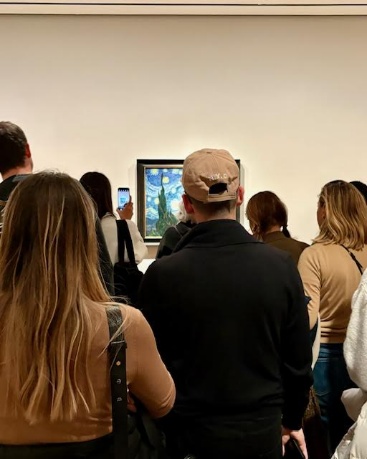
Museum visitors crowding around
Van Gogh’s Starry Night
at the Lillie Bliss exhibition
Bliss not only collected modern masterpieces but also recognized the connections between them and older art forms. The exhibition included textiles from the third to sixth centuries CE, the designs of which could have easily been created in the 1920s by a symbolist painter like Odilon Redon. A series of Gauguin’s Polynesian-inspired woodcut prints was just around the corner from the textiles. However, one of them, entitled Te Atua (The Gods), finished in 1894, reminded me not of the Pacific islands but, with its black figures against a reddish background, reminded me of ancient Greek pottery fragments.
By looking at Lillie Bliss in this way, as a collector, a philanthropist, and a source of funding for modern art in the early twentieth century, the museum tackled several subjects that need highlighting today. First is the role that collectors and benefactors play in the trajectory of art in the modern world. There is also the question of what Bliss’s life may say about women’s place in the arts. Large swaths of the art world, especially in the past, served almost like a no-girls-allowed treehouse club. Women are drawn to the arts just as much as men, yet gender roles imposed upon them often make many feel socially obligated to refrain from pursuing such a career. Sometimes, women are even intentionally excluded from such spaces. Failing to address the gender question more explicitly may be the exhibition’s sole shortcoming. With all the resistance Bliss faced in the promotion of modern art and the establishment of the museum, how did her gender play a role in the way that she was perceived? Of course, this question is made difficult by the fact that she remained anonymous when donating funds and loaning works to various exhibitions. Her gender may have played a role in her decision to do so. Yet, I wouldn’t put it past Americans in the 1920s to use gendered language when discussing Bliss’s involvement in modern art and the MoMA’s foundation.
While Bliss was not an artist herself, she used her wealth and privilege to collect and promote art that many at the time thought was negatively influencing society. I feel rather embarrassed and ashamed that, until this exhibition, I had no idea that a trio of women were the ones who founded the Museum of Modern Art. Hopefully, after they’re done taking their selfies with Starry Night in the background, more museum visitors may just remember Lillie Bliss alongside other famous names like Guggenheim and Getty, famous collectors and patrons who helped shape modern art in the United States.
Caravaggio’s Young Pope Premieres In Rome
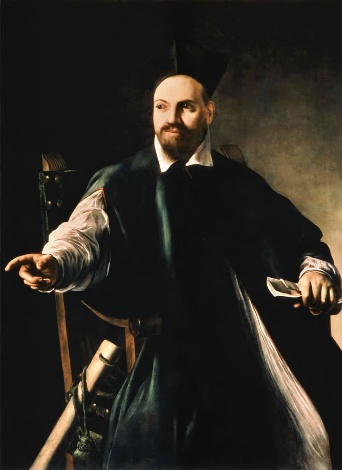
Portrait of Maffeo Barberini
by Michelangelo Merisi da Caravaggio
A Caravaggio portrait of a young pope, first positively attributed to the artist over six decades ago, has finally gone on public display for the first time ever.
Caravaggio created the portrait of Maffeo Barberini around 1598 when the priest was around 30 years old. He sits in a chair dressed simply in a green cassock and a black hat, holding a letter in his left hand. Most interestingly, though, Barberini looks off to the side and gestures with his other hand in the same direction, possibly interacting with some unseen person out of view. The painting is significant from an art-historical perspective because it’s so rare. Caravaggio was no stranger to figure painting, but few of his portraits survive today. The portrait remained with the Barberini family until the 1930s, with the current owners first acquiring it in the 1960s. It was first attributed to Caravaggio in 1963 when the art historian Roberto Longhi published his opinion in the academic journal Paragone. Longhi described the portrait as an example of “realtà atteggiata”, or staged reality. Caravaggio has taken a rather static art form, portraiture, and imbued it with action, with Barberini’s face and hand indicating movement and narrative elements. Barberini seemed pleased with the painting since he later commissioned Caravaggio to create a religious scene, The Sacrifice of Isaac, completed in 1603 and now housed at the Uffizi Gallery. The portrait went on display this past Saturday, November 23rd, as part of an exhibition at the Palazzo Barberini that will run through February 23, 2025.
Barberini became acquainted with Caravaggio through the artist’s patron, the Cardinal Francesco Maria del Monte. Barberini came from an influential Tuscan family that made their fortune as grain and wool merchants. They later used their money to buy church offices and gain social and political power. The family reached the pinnacle of its power through Maffeo, the subject of the Caravaggio portrait. He was a Jesuit-educated priest who would climb the ranks of the church to become the pope’s ambassador to France and then a cardinal. In 1623, Barberini was elected to the papacy under the name Urban VIII. During his rise to power, Barberini acquired an extensive list of assets, including art and property. He became a patron for many seventeenth-century artists like Bernini, da Cortona, Poussin, and Lorrain. Today, one of his residences in Rome, the Palazzo Barberini, houses one of the two locations of the Gallerie Nazionali di Arte Antica, one of the city’s great museums and Italy’s preeminent cultural institution dedicated to Old Master paintings.
There are still some questions as to the portrait’s provenance or if the subject is, in fact, Barberini. But now scholars and specialists have the painting in a controlled museum environment to study it and help fill in the still-vacant gaps in Caravaggio’s life and work. It may even help determine the authorship of another alleged Barberini portrait by Caravaggio at Rome’s Palazzo Corsini, the museum’s second location. After the exhibition closes, the museum will return the painting to its owners in Florence.
Annie Leibovitz’s Royal Unveiling
Renowned photographer Annie Leibovitz has recently unveiled her latest project: a double portrait of the king and queen of Spain.
For their twentieth anniversary, King Felipe VI and Queen Letizia posed for photographer Annie Lebovitz in a stunning display of glamour and wealth. On Monday, November 25th, the Bank of Spain hosted an exhibition at its central location in Madrid, where they unveiled the portraits for the first time. Annie Leibovitz got her start as a photographer for Rolling Stone, but this is not the first time Leibovitz has dealt with royalty. On two occasions, she took photos of Queen Elizabeth, once in 2007 and the other in 2016. Her style of portrait photography is rather well-suited for these sorts of subjects, given her use of staging and lighting to create a dramatic atmosphere. Leibovitz does not show the royal couple together in a single image, but rather each in their own portrait. The king stands in the Royal Palace’s Gasparini Hall in cool light, wearing his military uniform with several sashes and medals. Meanwhile, the queen wears a strapless black Balenciaga dress standing in a more warmly-lit area. She also has a red satin shawl, a diamond necklace, and diamond drop earrings. While they are separate photographic portraits, a chair partially appearing in both photos shows that the pair are standing at opposite sides of what could have been a single, wide shot. Art historian Yolanda Romero remarked that the photos are “paradoxically very pictorial”. This refers to not just their subjects but also their being printed on canvas rather than paper, making them seem more like paintings than just photos.
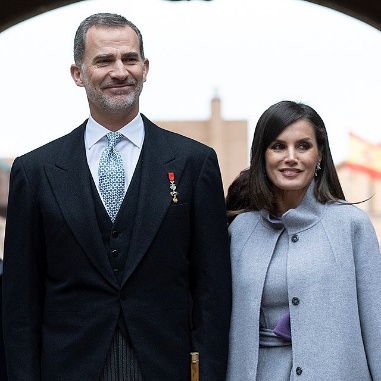
King Felipe VI & Queen Letizia
of Spain
(photo courtesy of Pool Moncloa
and Borja Puig de la Bellacasa)
While the Leibovitz portraits are beautifully arranged and executed, it is questionable whether such a display is wise for the royal family. Of all the monarchies remaining in Europe today, Spain is often the most at risk. While King Felipe has taken steps to improve the monarchy’s public image, the royal family has not yet fully recovered from the serious reputational blows they suffered due to a series of scandals and missteps between 2008 and 2012. Many have praised the Leibovitz portraits as capturing the grandeur of the crown, following in the footsteps of other famous Spanish royal portraitists like Francisco de Goya and Diego Velázquez. It shows the king and queen as strong figures on their own but also as a team. But of course, while the king poses in his military regalia against a palatial backdrop, it is not as opulent as I suppose it could have been.
Monarchies today must perform a balancing act in order to survive. They can easily be dismantled if they are seen as out of touch. However, if the royals seem far too ordinary and approachable, nothing makes them special, and they, therefore, have no reason to remain part of the state infrastructure. The monarchy’s critics are bound to denounce the portraits as an unnecessary expenditure (Leibovitz was paid €137K for the job) and a display of wealth and power at a time when Spain is not in the best shape. Nearly 20% of Spain’s population lives in or at risk of poverty, the country suffers from almost 12% unemployment, and most recently, a series of floods in Valencia has resulted in several hundred dead and prompted a government response, including €2.4 billion in aid. But at the same time, the monarchy represents tradition and stability, which many people look for in times of crisis. We shall see how the Spanish people respond to the Leibovitz portraits in due time.
____________________
One Newbie & Two Oldies, But Goodies
How To Safely Navigate The Art Market: Attributed To
(2024)
In the old days, dealers and auction rooms would only use the phrase Attributed To for works that, in an expert’s opinion, were more than likely by the artist in question. Of course, there was still a little uncertainty, since many of those works were often unsigned. However, when a buyer saw a work with that phrase attached to it, they had a good deal of confidence in its authenticity was backed by an expert’s thorough research and examination of the work.
While personally, I was never comfortable dealing with Attributed To works when I first started in the business, it was not a very worrying term. Often, it was used in the Old Master market since many works were never signed. Experts would analyze stylistic elements, provenance, and historical records before making their determination.
Unfortunately, the use of the term has changed, and not for the better.
Today, many questionable works are being offered at smaller auctions with the term Attributed To. In most cases, to those with a serious level of expertise in the field, it is often blatantly clear that these pieces have no connection to the artist they are supposedly attributed to. I would like to assume that these sellers feel the term is similar to those like: Studio of, Circle of, After, In the Style of, Manner of, and Follower of. Let me be perfectly clear, it is not.
In case you are unaware, here is what those terms really mean:
Studio of: A work created by an unknown artist within the studio of the named artist, potentially with their guidance or direct involvement.
Circle of: A piece by an unidentified artist associated with the named artist, but likely not a direct student.
After: A copy of an original work by the artist.
Manner of / In the Style of: A piece executed in the style of the artist but produced at a later date and not by the artist.
Follower of: A work created by an artist inspired by the named artist, but without necessarily being their pupil.
Over time, the misuse of Attributed To will undermine buyers’ confidence and the integrity of the art market. It is vitally important that people who are “not in the know” reach out to those who are “in the know” to make sure they are correctly cataloging the works being offered for sale.
How To Safely Navigate The Art Market: Quality
(from 2019)
Another key component to consider when buying art is quality – or, where, on a scale of 1 – 10, does any specific work stand in relation to their oeuvre? During your art world journey, many works will be available at any given time. If you have focused on a single artist, make sure that any of the works you are considering rank among their best – not just the best that are currently available. Let’s face it, sometimes what is “currently available” is a bunch of crap, especially when you are dealing with historical works of art!
Remember that even great artists had/have bad days and produced mediocre or poor-quality works. You should also note that some available works may be nothing more than a sketch or study and were never created to be sold; these were usually created in the development stages of more complex pieces. So you may be wondering, how did these works become available? Good question:
For my example, I will focus on the 19th century. During that period, it was common to have a studio sale after an artist’s death. The purpose of these sales was twofold:
1. To let the art world know that the output from this artist was over.
2. To sell off everything that remained in the artist’s estate to benefit the surviving relatives.
While these sales, at times, did include fully finished works, most often, they were filled with unfinished pieces, sketches, and preparatory studies. Please do not get me wrong; some of these preparatory works are now considered important on their own, but again, you need to know the best from the rest. You also need to be aware that there were times when another artist finished unfinished works from a studio sale. Yes, we have seen this. Now the question is – who do you attribute the painting to? I guess it all depends on how much of the original artist’s work is still visible.
If you widen your focus to a period or movement (Barbizon, Impressionist, Realist, Abstract, etc.) rather than a specific artist (Monet, Boudin, Corot, Dupré, etc.), you will have an easier time finding quality works simply because there should be a greater supply of good material to choose from. However, when broadening your scope, it is even more important to do your research and look at as many examples from the different artists of that period as possible. See which works have been heralded as the best so you have something to compare the currently available works to.
Distinguishing between good, mediocre, and poor-quality works is not something you can learn from reading a textbook. It comes from years of looking at and studying the physical works of art (not just photographs). In addition, you need to know which periods and subject matters of an artist are considered their best. Then, you need to determine when a specific work was created and how it relates to other works from that period, and then you can begin to determine if it is a good quality example.
You will find that almost every gallery, dealer, auction room, etc. you visit will tell you that their works are ‘the best’, ‘major examples’, or even ‘masterpieces’. But as we all know, this cannot be the case – not every painting is ‘the best’, etc. If you do a little homework, you will learn which dealers/galleries/auction rooms consistently offer great quality works and which are just selling a name (or signature).
It is also very important to remember that the best examples of an artist’s work will be more expensive than the mediocre ones. But as we always say… the best will always be the best, and second-rate work will always be just that.
How To Safely Navigate The Art Market – Conservation vs Restoration
(from 2019)
This month I thought I would continue my thoughts on a painting’s condition with a short article on restoration and conservation. Please keep in mind that this is a very brief discussion and I am only referring to oil paintings on canvas (no other support or medium – panel, paper, gouache, watercolor, etc.). To begin with, one should understand that there is a difference between restoration and conservation.
Conservation refers to the process of taking a damaged work and stabilizing it in order to prevent any additional deterioration or damage (in the case of mom’s expensive fine china … keeping it away from the children!). But seriously, let’s take a painting where the paint is lifting, or flaking, off the canvas. A conservator would stabilize the problem areas, correct the issue that was causing the lifting, and then might leave the work as is … or if they did fix the damages, those areas might still be visible.
Restoration refers to taking something (painting, furniture, silver, mom’s fine china, etc.) and returning it to the way it looked when originally created. So, if the paint on a canvas were flaking (again, paint actually falling off the canvas) the restorer would correct the problem that caused the flaking and then fix the damaged areas so that they looked as good as new. In other words, to the naked eye you could not tell that there was any damage.
In the real world (the one most people travel in) the words are used interchangeably and let’s face it, most people would enjoy looking at something that was restored rather than something that was just conserved. As you will soon see, in reality there may be very little difference between the restoration and conservation processes and, if needed and done correctly, either will greatly benefit your artwork.
Once you have determined that a painting needs some care, there is only one thing you should do…. consult a professional. The restoration/conservation of a work of art is a very delicate procedure and should only be attempted by an expert (for the balance of this article I will use the words restore and restorer). I also believe that if you own a work of art, you are its caretaker and it is your responsibility to preserve it for the benefit of future generations … remember, you are caring for a piece of history.
There are restorers throughout the world, and many are very good at what they do. In order to find the right one, I suggest that you contact dealers you have confidence in and get their recommendation – you may even find that your dealer of choice may be happy to take care of the entire process for you.
However, should you decide to ‘do it yourself’ (find a restorer that is) the next step is to do a little research and find those who not only have a good reputation, but have handled works from the same period as the work you have. Then call and either set up an appointment to bring the work in (if they are local) or begin by sending detailed photos of the work. Don’t be afraid to contact restorers in other cities – in New York alone, there are dozens of well-trained restorers and the more competition, the better the price.
While it is important to hire someone who has worked on other paintings from the period, it is even better if you can find one who has handled works by the specific artist. Keep in mind that each artist has/had a particular way of painting and used certain pigments and varnishes. The more works a restorer has handled by an artist, the more familiar they will be with their materials and working methods.
After the restorer has examined the work, they will tell you what needs to be done. Ask questions about the condition of your painting and try to learn what caused the damage so you can prevent it from happening again (was it exposed to light, heat, etc.). And most importantly, get an estimate and a detailed explanation of what they are going to do.
During your discussion with the restorer, they may use words or phrases that are foreign to you. Below I have outlined a very basic restoration procedure for an oil painting on canvas and have used some of the ‘technical’ words and phrases you may hear.
Normally the first thing that needs to be done to an old painting is a:
Cleaning – in this process the restorer uses a variety of chemicals to remove the old, dirty, varnish. Over time many varnishes have a tendency to yellow and this causes the work to look dull and dirty. By removing this varnish, the original layer of paint will be exposed, and all the original colors will be visible. Please, do not try this at home. While one can buy most of the chemicals needed at their local hardware store, it is the professional’s knowledge of their proper mixture that prevents them from damaging the work. The wrong mixture will cause serious damage!
During the cleaning process not only will the old varnish be removed, but any old inpainting will also come off. It is at this time that you may receive a phone call from your restorer informing you that the work is in better, or worse, shape than they thought.
They may also inform you that your work might need a:
Treatment – a process that uses humidity from a chemical/water mixture to relax structural cracks in a painting.
And/or a:
Relining – a process in which the back of the old canvas is attached to a new canvas to give it support.
This is normally accomplished with the use of a:
Vacuum/Hot Table – a large smooth table that allows the restorer to heat a painting, under pressure, to a desired temperature so that any cracking can be addressed, and the relining can be done.
Years ago, the standard bonding agents used in the relining process were rabbit skin glue or wax, today many restorers use:
BEVA 371 – this adhesive, unlike the other two, is fully reversible and much easier and cleaner to use. This will be important if the work ever needs to be restored in the future.
Once the work has been re-lined, the next step is to place it back on its stretcher (the wood supports on the back) and repair (if necessary) any areas where there is paint loss. In order to do that, the areas of loss will need:
Fillings – something like a visit to the dentist to have a cavity filled, however a restorer will often use spackle to build up the lost area of paint so that it is almost even with the uppermost paint layer.
After the fillings have dried, the next step is to make sure they are level and smooth. Then, they spray a layer of:
Varnish – this will place a protective coating between the original paint and any restoration that is done.
After this layer has dried, the restorer will begin to:
Inpaint – using restorer’s pigments to color the fillings so they match the surrounding area. Like other products used in this process, these paints, since they do not dry as hard as oil paint, are fully reversible.
After the inpainting has dried, the final step is to give the work a:
Finishing Varnish – a final layer of varnish that protects both the original painting and any restoration that was done. There are several finishes that can be used – matte, semi-gloss, gloss, etc. The right one is often a matter of personal preference.
Below are before and after cleaning images of a painting by Daniel Ridgway Knight. In this case, the painting only needed to be cleaned and varnished, but you can see the dramatic results.
Before and After Cleaning
Again, this is a very brief introduction to the restoration and conservation processes. Works on paper or panel may require different treatments, and sometimes oil paintings need more complex intervention – like those that have been relined in the past, etc.
The Rehs Family
© Rehs Galleries, Inc., New York – December 2024

